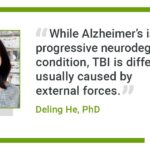August 01, 2025
4 min read
Key takeaways:
- Taking 7,000 daily steps can lower risk for several health outcomes including all-cause death, cancer mortality, cardiovascular disease and more.
- Step counts include incidental activities.
Taking 7,000 steps per day can significantly reduce the risk for several health outcomes including death, cardiovascular disease, cancer mortality, dementia and more.
Individuals do not need to walk for a certain length of time to achieve these results. Rather, steps can include mundane tasks such as going to the bathroom or grocery shopping.

Data derived from Ding D, et al. Lancet Public Health. 2025;doi:10.1016/S2468-2667(25)00164-1.

Melody Ding
“This is something that public health really needs to capitalize on, otherwise it will be a missed opportunity,” Melody Ding, PhD, MPH, professor in the Sydney School of Public Health at The University of Sydney, told Healio.
‘More accessible’ measurements needed
Global guidelines have recommended individuals perform 150 minutes of moderate-intensity physical activity or 75 minutes of vigorous-intensity physical activity per week, according to study background.
Researchers have estimated not reaching these benchmarks can account for up to 8% of noncommunicable diseases and billions in health care costs.
“When you ask most people how many minutes of moderate- or vigorous-intensity activity they did this week, I’m sure they can’t tell you because it’s something really hard to track, and it also doesn’t take into account incidental activities,” Ding said. “It just needs to be supplemented with some measures that are more accessible and more interpretable for the general public.”
Many individuals are “hooked on” walking 10,000 steps to improve health-related outcomes, Ding said, but the basis for that number does not come from research.
“It actually arose from a Japanese brand of pedometers many years ago,” Ding explained. “They call it in Japanese 10,000 steps, and somehow that got lost in translation. Everybody thinks we need 10,000 steps.”
Furthermore, many studies investigating step counts have focused primarily on all-cause mortality.
“There are 10 papers meta-analyzing all-cause mortality, but there are so many other outcomes that matter for informing public health guidelines,” Ding said. “We really need to assess a broad range of outcomes.”
Ding and colleagues conducted a meta-analysis of 31 studies (24 cohorts) published between Jan. 1, 2014, and Feb. 14, 2025, to examine how daily steps impact health, which served as their primary endpoint.
They examined nine outcomes: all-cause mortality (14 studies), cardiovascular disease incidence (6) and mortality (3), cancer incidence (2) and mortality (3), type 2 diabetes (4), dementia (2), depressive symptoms (3) and falls (4).
The researchers used 2,000 steps as a reference and examined risk through increments of 1,000 up to 12,000.
‘Really awesome’
Researchers found 7,000 daily steps significantly reduced the risk for all-cause mortality (HR = 0.53; 95% CI, 0.46-0.6), cardiovascular disease incidence (HR = 0.75; 95% CI, 0.67-0.85) and mortality (HR = 0.53; 95% CI, 0.37-0.77), cancer mortality (HR = 0.63; 95% CI, 0.55-0.72), type 2 diabetes (HR = 0.86; 95% CI, 0.74-0.99), dementia (HR = 0.62; 95% CI, 0.53-0.73), depressive symptoms (HR = 0.78; 95% CI, 0.73-0.83) and falls (HR = 0.72; 95% CI, 0.65-0.81).
Additionally, 7,000 steps reduced the risk for cancer incidence by 6%, though the data just missed the threshold for statistical significance.
Ding expected 7,000 steps would have varying degrees of efficacy, but she expressed surprise for dementia and depressive symptoms.
“I think it’s really awesome,” she said.
Increasing steps to 10,000 improved a couple of health outcomes, including cardiovascular disease incidence (HR = 0.7; 95% CI, 0.62-0.79), depressive symptoms (HR = 0.67; 95% CI, 0.61-0.75), type 2 diabetes (HR = 0.78; 95% CI, 0.61-0.99) and dementia (HR = 0.55; 95% CI, 0.46-0.66), but others plateaued around 7,000.
“Seven thousand steps could be quite an accessible and achievable target for relatively comparable health benefits compared with 10,000 steps,” Ding said.
Individuals can get benefits from steps even if they do not hit 7,000.
“Even if you compare 4,000 against 2,000, which is a really low baseline — that’s for people who are basically intentionally not trying to do much — you see quite a bit of risk reduction,” Ding said. “It’s important that we encourage people if they’re doing nothing to start doing something, because that something can give you quite efficient return on investment.”
Researchers acknowledged study limitations, including the limited number of studies for several health outcomes investigated.
The lack of studies to pull from highlights the need for more research to confirm the impact steps have on outcomes outside of all-cause mortality.
Additionally, Ding wants to look deeper into how age and pace may play a role in the number of steps needed or effect size.
Studies into specific cancers are warranted, too.
Those will take time, but Ding emphasized the importance of physicians promoting daily steps to their patients now.
“Health care professionals have been an underutilized resource for promoting healthy lifestyle, and I think part of it is our society is quite obsessed with quick fix. We want to pop a pill,” Ding said. “We’ve known for centuries or millennia that physical activity is good for you and that’s not necessarily something we can replace with supplements or other things we tend to get a bit obsessed about.
“This one is not just going to go away, no matter how many supplements you take, no matter how many treatments you do,” she added. “You can’t get away with not moving your body.”
For more information:
Melody Ding, PhD, MPH, can be reached at melody.ding@sydney.edu.au.











